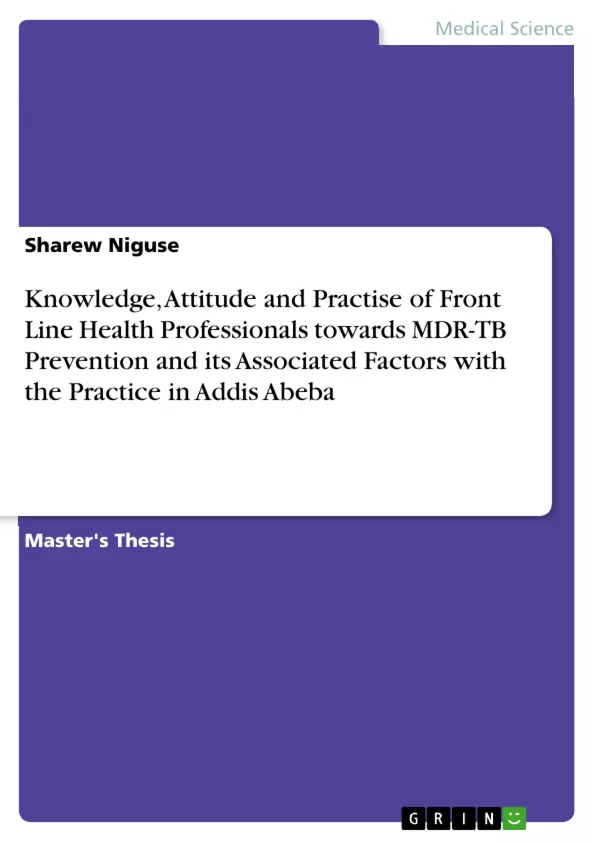Tuberculosis is an infection caused by Mycobacterium tuberculosis and most of the time affects lung (pulmonary tuberclosis). When it is not treated effectively it will develop resistance to medication and it will results in drug resistance tuberculosis. Globally, 3.5% of new and 20.5% of previously treated tuberclosis cases was estimated to have had Multi-Drug Resistance Tuberculosis in 2013. One of the factors of an increase for Multi drug resistance tuberculosis is the health professionals’ Knowledge, attitude and practice towards MDR TB prevention. Hence, this study will have contributed an input for further studies.
Inhaltsverzeichnis (Table of Contents)
- INTRODUCTION
- BACKGROUND
- STATEMENT OF THE PROBLEM
- SIGNIFICANCE OF THE STUDY
- OBJECTIVE
- General objective
- Specific objectives
- METHODS
- Study design
- Study area/Study Period
- Population
- Source population
- Study population
- Sample size & sampling procedures
- Inclusion and exclusion criteria
- Inclusion criteria
- Exclusion criteria
- Variable
- Dependent variables
- Independent variables
- Operational definitions
- Data collection tool and procedure
- Data quality management
- Ethical considerations
- RESULTS
- Socio demographic characteristics of the respondents
- Knowledge of frontline health workers about MDR TB
- Attitude of frontline health workers towards MDR TB prevention
- Practice of frontline health professionals towards MDR TB prevention
- DISCUSSION
- LIMITATION OF THE STUDY
- CONCLUSION
- REFERENCES
- QUESTIONNAIRES
Zielsetzung und Themenschwerpunkte (Objectives and Key Themes)
This thesis aims to assess the knowledge, attitude, and practice of frontline health professionals towards MDR TB prevention in Addis Ababa, Ethiopia. It also seeks to identify factors associated with the practice of these professionals.
- Knowledge of frontline health professionals regarding MDR TB
- Attitudes of frontline health professionals towards MDR TB prevention
- Practice of frontline health professionals regarding MDR TB prevention
- Factors associated with the practice of frontline health professionals towards MDR TB prevention
- Implications for public health interventions to improve MDR TB prevention practices
Zusammenfassung der Kapitel (Chapter Summaries)
The introduction of the thesis provides background information on MDR TB, including its prevalence, impact, and challenges. The study's problem statement outlines the need for a comprehensive understanding of the knowledge, attitude, and practice of frontline health professionals in relation to MDR TB prevention. The significance of the study is highlighted by the potential contribution to improving MDR TB prevention efforts in Addis Ababa. The chapter on "Objectives" clarifies the general and specific objectives of the study. The "Methods" section details the study design, population, sampling procedures, data collection tools, and ethical considerations employed in the research. The "Results" chapter presents the findings of the study, focusing on the socio-demographic characteristics of respondents, their knowledge about MDR TB, their attitudes towards MDR TB prevention, their practices related to MDR TB prevention, and the factors associated with these practices.
Schlüsselwörter (Keywords)
The study centers on key concepts such as knowledge, attitude, and practice, as applied to frontline health professionals and their engagement with MDR TB prevention. Important themes include the prevalence and impact of MDR TB, associated factors influencing prevention practices, and the implications of findings for public health interventions. Key terms like multi drug resistance tuberculosis (MDR TB), Direct Observed Treatment (DOT), and Bacille Calmette-Guérin (BCG) are prominent within the study's scope.
- Arbeit zitieren
- Sharew Niguse (Autor:in), 2015, Knowledge, Attitude and Practise of Front Line Health Professionals towards MDR-TB Prevention and its Associated Factors with the Practice in Addis Abeba, München, GRIN Verlag, https://www.grin.com/document/368322



